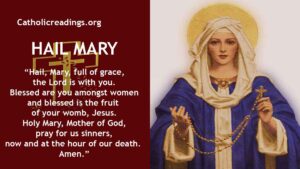The Hail Mary Full of Grace prayer is special and cherished in the Catholic tradition. It’s like a friendly conversation with Mary, the mother of Jesus.
When people say the Hail Mary, they’re asking Mary for help and guidance. It begins with a greeting, “Hail Mary,” showing respect and admiration.
Then, it mentions how blessed Mary is among women and praises her son, Jesus. Finally, it asks Mary to pray for us, seeking her support and intercession.
The Hail Mary is a way for believers to connect with Mary, seeking her assistance and finding comfort in their faith.
Hail Mary Full of Grace
Hail, Mary, full of grace, the Lord is with you.
Blessed are you amongst women
and blessed is the fruit of your womb, Jesus.
pray for us sinners,
now and at the hour of our death. Amen.
Ave Maria – Latin
| Ave Maria, gratia plena, | Hail Mary, full of grace, |
| Dominus tecum. | The Lord is with thee. |
| Benedicta tu in mulieribus, | Blessed art thou amongst women, |
| et benedictus fructus ventris tui, Iesus. | and blessed is the fruit of thy womb, Jesus. |
| Sancta Maria, Mater Dei, | Holy Mary, Mother of God, |
| ora pro nobis peccatoribus, nunc, | pray for us sinners, |
| et in hora mortis nostrae. Amen. | now and at the hour of our death. Amen. |
What is the Hail Mary Prayer
The Hail Mary is a cherished and widely recited Catholic prayer that holds deep significance within the Christian faith.
It is a reverent plea to the Virgin Mary, the mother of Jesus, seeking her intercession and invoking her maternal love and compassion.
The prayer begins with the words spoken by the angel Gabriel to Mary at the Annunciation, acknowledging her as “full of grace” and blessed among women.
It then continues with a humble request for her prayers, asking her to pray for us sinners both in the present and at the hour of our death.
The Hail Mary is a beautiful expression of devotion and trust in the Blessed Mother, seeking her powerful intercession and entrusting ourselves to her maternal care.

Parts of Hail Mary
The first part of Hail Mary contains the words of the archangel Gabriel when he came to Mary to announce to her the good news about her being the mother of our Lord and Saviour.
28 And coming to her, he said, “Hail, favoured one! The Lord is with you.”
Luke 1:28
The second part contains the words of Elizabeth, the mother of St John the Baptist which she used when greeting her visitor, the Blessed Virgin Mary.
42 [Elizabeth] cried out in a loud voice and said, “Most blessed are you among women, and blessed is the fruit of your womb…”
Luke 1:42
The last part, which is a request for intercession by our Mother Mary, was added to the Hail Mary prayer during the 14th or 15th century.
This petition for intercession was added around 1555 AD during the period of the Council of Trent by St Petrus Canisius, a Dutch Jesuit, who added in his Catechism the words “Holy Mary, Mother of God, pray for us sinners.”
In 1566, the same words were added to the Catechism of the Council of Trent and in 1568 AD, it was officially added to the revised Roman Breviary by Pope Pius V.
Hail Mary is part of the following prayers
- The Angelus
- The Rosary
- The Way of the Cross
- In many Novenas
Conclusion
In conclusion, the Hail Mary prayer is a deeply cherished and widely recited prayer in the Christian tradition, particularly in the Catholic faith.
It is a humble and reverent plea to the Virgin Mary, seeking her intercession and guidance. The prayer acknowledges her role as the Mother of Jesus and asks for her prayers on behalf of the one reciting it.
Through its simplicity and repetition, the Hail Mary fosters a sense of connection with the divine and serves as a reminder of the grace and mercy believed to be bestowed through Mary’s intercession.
Many find comfort and solace in the rhythmic words of this prayer, making it a timeless and meaningful expression of faith for countless believers around the world.
Related Links
Powered By SEO Experts
Follow @ReadingCatholic
